The horrible problems happening at the Japanese nuclear reactor have caught everyone’s attention, and have understandably spooked a lot of people about the dangers of nuclear energy. First, some facts about nuclear energy in the US. There are currently 104 nuclear reactors licensed to operate at 65 plants in the United States, which generate about 20% of the nation’s electricity. The plants are located in 32 different states, with the majority of them being east of the Mississippi river. The state with the most reactors is Illinois with 11 reactors in 6 plants. ((http://www.nrc.gov/reactors/operating/list-power-reactor-units.html))
As it happens, Illinois is where I live, and there is a reactor about 30 miles from my house. That means we’re in the ingestion pathway Emergency Planning Zone, which basically means we’ll need to get our garden and well tested if there’s a radiation leak at the plant. I hadn’t realized just how close we were to this plant or that my home state was host to the most active reactors. I’ve been a proponent of nuclear power, believing that in the long term, it was the source that could give us the most energy with the least long term impact on our environment and our lives. After some cursory research for a Facebook post, I realized that I didn’t have all of the details to be as informed as I wanted to be, so I decided to go in-depth and see if my beliefs about nuclear power were merited. Hopefully my work will help anyone else who wants to approach nuclear power from an educated position.
A Big Pie to Fill
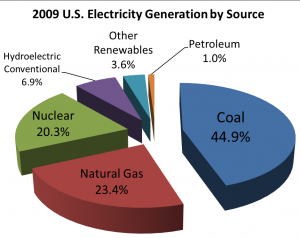
The US has a huge need for electricity, that’s something we just have to accept. Yes we should reduce our usage, but I want to focus on how to best meet our current needs, and not be sidetracked by how the energy is used. Currently our power comes from 4 main sources: Coal (45%), Natural Gas (23%), Nuclear (20%), and Hydroelectricity (7%), with the remaining 5% being made up by Oil and renewable resources such as Wind, Solar, Geothermal, etc. ((http://en.wikipedia.org/wiki/Electricity_sector_in_the_United_States#Electricity_generation)) While I see an increase in the use of solar and wind power as essential to our long term electricity needs, it won’t be able to meet all of our needs, or even a large percentage. President Obama has pledged to double the amount of energy created by alternative energy but, if successful, that will move the percentage from 3.5% to 7%; at a cost of about $45 billion. That’s still a long way from the 20% we currently get from nuclear.
The reality is that we can’t meet current demand with alternative energy sources alone. Electricity from renewable sources can still play a part, but without a technological breakthrough it won’t be able to supply more than 10% of our current needs. So if our decision is down to which of the 3 main electricity generation sources we should encourage and expand, how does Nuclear compare to Natural Gas and Coal?
Economics
From an economic standpoint, Coal and Natural Gas are hard to beat. The table below shows the “life-time” cost per MWh (MegaWatt hour) from several sources. On the face of it, Wind appears to be a strong economic contender, but looking at the government subsidies used to provide wind energy, the cost quickly passes Nuclear. Solar is in an even worse state. Both of these will improve as the technologies are advanced, but we seem to be a long way off from them becoming the most economically efficient option. So, from a purely financial stance, we should be pushing more and more coal and natural gas and less and less nuclear and hydro.
| Technology | Cost per MWh | Subsidy per MWh | Real cost per MWh |
|---|---|---|---|
| Coal | $53.10 | $0.44 | $53.54 |
| Natural Gas | $52.50 | $0.25 | $52.75 |
| Nuclear | $59.30 | $1.59 | $60.89 |
| Hydro | $60.00 | $0.67 | $60.67 |
| Solar | $150.00 | $24.34 | $174.34 |
| Wind | $55.80 | $23.37 | $79.17 |
References: ((http://online.wsj.com/article/SB121055427930584069.html?mod=opinion_main_review_and_outlooks)), ((http://en.wikipedia.org/wiki/Economics_of_new_nuclear_power_plants#Comparisons_with_other_power_sources))
However, there are obviously other factors to consider beyond the dollar costs of generation. One often sited reason for changing from the standard energy production sources is reliance on foreign countries. When it comes to electricity though, foreign oil makes up a very small percentage of our production, so we can keep that out of the discussion. How about Coal and Natural Gas? The US only imports 16% of it’s natural gas from other countries, and 82% of that comes from Canada ((http://fossil.energy.gov/programs/gasregulation/analyses/Frequently_Asked_Questions.html#Q4)). As for coal, the US has lots of it and even exports it (59.1 million short tons in 2009) ((http://www.eia.doe.gov/cneaf/coal/page/special/exports_imports.html)). Another win for Coal and Natural Gas. So what is it that would lead us away from these two seemingly obvious solutions and toward Nuclear or renewable sources?
Safety & Environmental Impacts

While it may seem counter-intuitive, the safety of Nuclear energy and it’s minimal impact on the environment may be two of it’s biggest selling points. A report released shortly after Fukushima had a very stunning graphic that tried to lay out the the number of lives lost for each unit of energy generated ((http://sethgodin.typepad.com/seths_blog/2011/03/the-triumph-of-coal-marketing.html)). The image, based on data collected from the World Health Organization and several other sources going back to 1969, shows that the number of deaths for each TWh of electricity generated by Coal and Oil vastly outnumbers those from Nuclear (the little black dot in the bottom left of the image) ((http://nextbigfuture.com/2011/03/deaths-per-twh-by-energy-source.html)). With the internal violence of a nuclear reaction, and the deadly nature of radiation, how can it be that this is safer than burning ordinary fossil fuels? There are many dangers that come with any type of electrical production, let’s look at some of them.
Dangers from Coal
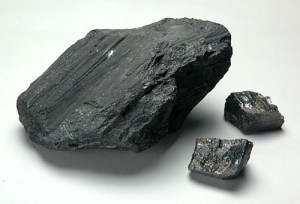 Coal has several threats, some of which may not be obvious. To begin with, mining coal is a dangerous endeaver in itself. You only have to look at the recent mine collapses in Chile and West Virginia to see what can happen on a grand scale, but there are many more, smaller incidents that happen more frequently. From 1996 to 2009, the US averaged over 33 deaths a year in mining ((http://en.wikipedia.org/wiki/Coal_power_in_the_United_States#Safety)). In addition to direct mining deaths, there are many environmental impacts from coal fired power plants. Coal power plants output large amounts of sulfur dioxide and carbon dioxide into the air. They also emit 32.6% of all airborne Mercury in the US ((http://en.wikipedia.org/wiki/Coal_power_in_the_United_States#Mercury_pollution)). In addition, when burning coal, there is an ash leftover that can not be burned. The environmental impact of this waste is not totally understood, but the EPA has just begun to consider monitoring and regulating the approximately 300 dry landfills and close to 600 coal ash waste ponds spread across 45 states ((http://thenationshealth.aphapublications.org/content/40/9/1.2.full)). According to an article at Scientific American, coal ash may actually be more radioactive than nuclear plants. Saying that due to the radioactive particles (uranium and thorium) being concentrated by the burning process, coal ash piles carry into the surrounding environment 100 times more radiation than a nuclear power plant producing the same amount of energy ((http://www.scientificamerican.com/article.cfm?id=coal-ash-is-more-radioactive-than-nuclear-waste)).
Coal has several threats, some of which may not be obvious. To begin with, mining coal is a dangerous endeaver in itself. You only have to look at the recent mine collapses in Chile and West Virginia to see what can happen on a grand scale, but there are many more, smaller incidents that happen more frequently. From 1996 to 2009, the US averaged over 33 deaths a year in mining ((http://en.wikipedia.org/wiki/Coal_power_in_the_United_States#Safety)). In addition to direct mining deaths, there are many environmental impacts from coal fired power plants. Coal power plants output large amounts of sulfur dioxide and carbon dioxide into the air. They also emit 32.6% of all airborne Mercury in the US ((http://en.wikipedia.org/wiki/Coal_power_in_the_United_States#Mercury_pollution)). In addition, when burning coal, there is an ash leftover that can not be burned. The environmental impact of this waste is not totally understood, but the EPA has just begun to consider monitoring and regulating the approximately 300 dry landfills and close to 600 coal ash waste ponds spread across 45 states ((http://thenationshealth.aphapublications.org/content/40/9/1.2.full)). According to an article at Scientific American, coal ash may actually be more radioactive than nuclear plants. Saying that due to the radioactive particles (uranium and thorium) being concentrated by the burning process, coal ash piles carry into the surrounding environment 100 times more radiation than a nuclear power plant producing the same amount of energy ((http://www.scientificamerican.com/article.cfm?id=coal-ash-is-more-radioactive-than-nuclear-waste)).
Dangers from Natural Gas
 Natural gas seems to be the cleanest traditional power generating fuel. While any carbon burning process will release large amounts of carbon dioxide, natural gas releases less than most, and doesn’t release sulfur the way most coal does. Natural Gas is often collected alongside oil as it often exists in oil wells. A new technique, called hydro fracking, though has allowed deposits of natural gas trapped in shale deposits to be mined. There are many unknowns about the process and how it will affect water supplies as it uses large amounts of water mixed with sand and the chemicals used in the process are being dumped with little controls in place ((http://climateprogress.org/2011/02/27/natural-gas-fracking-dangers-environment-health/)). Of course natural gas is highly flamable, so it’s storage and transportation does come with risks, and there are no good methods of extinguishing liquified natural gas fires without being able to cap the source ((http://www.firefighting.org/index.cfm?Section=27&PageNum=167)). But compared to coal, Natural Gas is a much safer source of energy.
Natural gas seems to be the cleanest traditional power generating fuel. While any carbon burning process will release large amounts of carbon dioxide, natural gas releases less than most, and doesn’t release sulfur the way most coal does. Natural Gas is often collected alongside oil as it often exists in oil wells. A new technique, called hydro fracking, though has allowed deposits of natural gas trapped in shale deposits to be mined. There are many unknowns about the process and how it will affect water supplies as it uses large amounts of water mixed with sand and the chemicals used in the process are being dumped with little controls in place ((http://climateprogress.org/2011/02/27/natural-gas-fracking-dangers-environment-health/)). Of course natural gas is highly flamable, so it’s storage and transportation does come with risks, and there are no good methods of extinguishing liquified natural gas fires without being able to cap the source ((http://www.firefighting.org/index.cfm?Section=27&PageNum=167)). But compared to coal, Natural Gas is a much safer source of energy.
Dangers from Nuclear
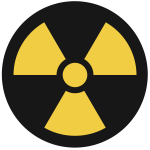 As I said at the beginning, there are many fears surrounding Nuclear energy. The two main risks associated with nuclear energy; nuclear plant accidents and nuclear waste disposal. Both of them are serious factors that need to be addressed separately as they each have different sources, different time frames, and ultimately different solutions.
As I said at the beginning, there are many fears surrounding Nuclear energy. The two main risks associated with nuclear energy; nuclear plant accidents and nuclear waste disposal. Both of them are serious factors that need to be addressed separately as they each have different sources, different time frames, and ultimately different solutions.
Nuclear Plant Accidents
There have now been three accidents that people think of when considering Nuclear power plants. Much has been made of the problems at the Fukushima power plant, and rightly so. Prior to that there was the Three Mile Island accident in Pennsylvania, and any discussion of nuclear power plant accidents would be remiss without mentioning Chernobyl. One of the key factors to remember about nuclear plants is that not all are designed with the same attention to safety and, in fact, not the same techniques for achieving safety. The age of a facility plays a part in that since new technologies have become available as the nuclear industry matures. Age also contributes to the “wear and tear” on a plant. The 40 year old Fukushima reactors, for example, were due to be decommissioned at the end of March, 2011 ((http://www.forbes.com/2011/03/16/japan-disaster-nuclear-opinions-roubini-economics.html)). So are we in danger of a Chernobyl or Fukushima here in the US? The two accidents were very different, first let’s look at Chernobyl.
The accident at Chernobyl happened when a test was run with several safety systems mistakenly turned off which caused too much energy to go into the reaction resulting in an explosion. Initially the mistakes made were attributed to operator error, but further studies revealed that the training and design of the reactor were more to blame for the size of the accident ((http://en.wikipedia.org/wiki/Chernobyl#Operating_instructions_and_design_deficiencies_found)). The Chernobyl reactor was designed very differently than US reactors, and did not have a containment vessel to surrounded the reactor itself. Because of this, much of the radiation from the explosion was sent into the air. In the Fukushima plant, the problem was not an explosion, but rather an overheating of the fuel rods currently in use, as well as the spent fuel rods stored on-site. As long as the power was kept up to keep water circulating over the fuel rods, the Fukushima plant would have been safe, even though it wouldn’t have been able to produce power for a while. The backup generators meant to keep it’s power running were placed in the basement of the plant and were overwhelmed by the tsunami.
In fact, 25% of the current US reactors use the GE Mark I reactor design that was in place at Fukushima. This reactor design was created over 40 years ago. So, it’s true that many US nuclear plants are susceptible to the same kind of accident. Not really reassuring, although considering the extreme level of catastrophes that happened in Japan, I think you have to take into consideration the likelihood of it happening.
| # of Reactors |
Operating years (age) |
|---|---|
| 7 | 40+ |
| 46 | 30-39 |
| 48 | 20-29 |
| 3 | 10-19 |
| 0 | 0-9 |
The real lesson to be learned is that age can be a big factor in the safety of a plant. Whether because of wear on the equipment, or design of the reactor. In the US, just over half of the active reactors are over 30 years old, and all but 3 are older than 20. Much of the reason that the US reactors are so old is that new plant production has fallen off drastically in the past 25 years. You can see in this table that there have only been 3 new reactors built in the past 20 years. How can we expect advances in the technology if those that want to use it are not allowed to by overly restrictive regulations and policies that are hostile to new construction? In January of 2010, President Obama gave a big boost to nuclear power by offering to increase loan guarantees for new Nuclear plant construction and creating a panel to study handling of nuclear waste ((http://www.nytimes.com/2010/01/22/science/earth/30nuke.html)). It’s still to be seen if any of this will happen in the light of Fukushima.
A new generation of nuclear reactors are being and have been developed that provide improved safety and efficiency, and lower construction costs ((http://en.wikipedia.org/wiki/Generation_III_reactor)). One of these new reactors that has received final design approval from the NRC ((http://www.nrc.gov/)) is the GE Ap1000. The cool-down process in it does not rely on any external or diesel power to be initiated the way the reactors at Fukushima did. It isn’t without it’s detractors, but it is moving forward, and the NRC plans to certify it by the end of the year. China already has plans for 12 AP1000 reactors ((http://en.wikipedia.org/wiki/AP1000)). In addition to these, there are further generations of reactors such as breeder reactors that can improve efficiencies and reduce waste.
Nuclear Waste Disposal

The more difficult danger from Nuclear energy is the nuclear waste. Nuclear waste from power generation largely consists of the “spent” fuel rods that can no longer be used to create electricity. In reality, there are still large amounts of uranium and plutonium still in the rods, but they have absorbed too many neutrons to continue to produce a reaction. They are certainly still radioactive and have to be kept out of the air or they will catch fire and burn, releasing radiation. ((http://en.wikipedia.org/wiki/Nuclear_waste#Back_end)). Currently, in the US, most of the spent fuel rods are stored on-site at the 65 power plants all over the US. A proposed long-term storage facility at Yucca Mountain in Nevada was finally canceled on April 14, 2011 by Congress after being in doubt for years and spending billions of dollars and missing the original opening date of 1998 by over 12 years due to legal challenges. The amount of study and background work done in picking this site is pretty substantial, and dates back to 1978, over 30 years ago! The main roadblocks seem to be political as scientists from many different organizations; government, university, and private industry; have agreed that the site will be safe. The Department of Energy currently estimates that for the next million years the facility will not put off more than 1 mrem/year. If a million years seems like an extreme number to quote here, the EPA actually set a standard of mrem/year for both the next 10,000 and 1 million years. The two levels were 15 and 100 mrem/year respectively, so you can see that the estimated levels released from the Yucca Mountain facility would be well below that ((http://en.wikipedia.org/wiki/Yucca_Mountain_nuclear_waste_repository)).
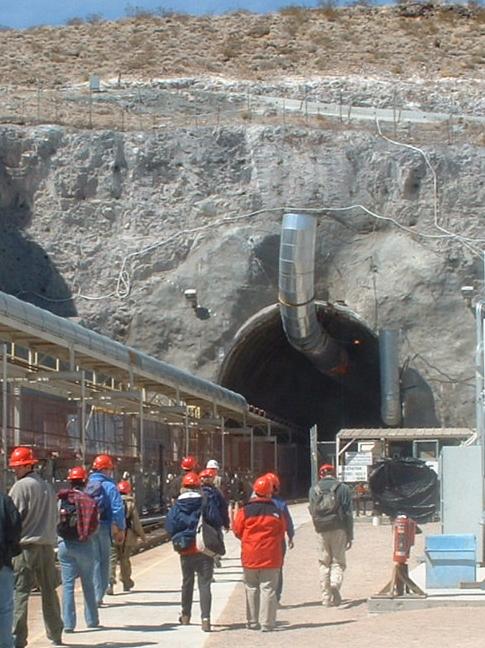
The other objection to the Yucca Mountain site has been from people concerned about transportation of the waste across the country to the facility. To these people I can only point to the work that has been done to assure the safety of the shipping containers as well as the track record in the UK where they have shipped over 14,000 casks of waste all over the world with no accidents for the past 35 years ((http://en.wikipedia.org/wiki/Spent_nuclear_fuel_shipping_cask)). So currently the US has no plan for storing or handling waste beyond keeping it in retention pools on site at nuclear plants. I might point out that these are the same kind of pools that have been one of the major concerns at the Fukushima plant.
The final area that must be discussed pertaining to nuclear waste is reprocessing. Reprocessing spent fuel rods consists of treating the rods with a series of chemicals to extract the uranium and plutonium from the fission products so that the rods can be reused in power plants to get more reactions from them. Reprocessing spent fuel rods does two things. First, by removing the reusable components and putting them back into action, it reduces the amount of high-level nuclear waste that must be stored by a factor of 10. Second by reintroducing them into a plant, it can increase the energy extracted from each kilo of natural uranium by 60 times. However, this last point has not had a big impact since current raw mined uranium prices are low enough to make it not cost effective ((http://en.wikipedia.org/wiki/Nuclear_reprocessing)). If uranium in the ground were to become more scarce, or more expensive, or if it was decided that mining it was becoming too invasive, recycling the spent rods would make more financial sense. Given it’s reduction of high level waste storage, it may make sense for government subsidies to cover the cost.
One big concern with reprocessing spent fuel rods is that it can produce refined plutonium usable in nuclear weapons. While this is a concern, the chemicals that are needed for reprocessing are complex and are closely monitored by the UN. In addition, newer reprocessing methods are more efficient, more compact, and reduce the risk of proliferation ((http://en.wikipedia.org/wiki/Nuclear_reprocessing#UREX)). The US had banned reprocessing in 1978 in an effort to encourage other countries to stop their reprocessing efforts as well, but several European countries continued the practice, including France and the United Kingdom who now process spent fuel rods for other countries around the world. Japan also has a reprocessing plant in use today. The US ban was listed in 1981, but no subsidies were provided to make it economically viable.
In Summary
Going into this article, I was feeling strongly in favor of Nuclear energy. I still feel that Nuclear energy is the only way to meet the demand that must be met if we continue to want to reduce our reliance on coal and natural gas. However, while writing this, I realized the sorry state of many of the currently active nuclear power plants in the US, and the lack of urgency towards replacing them. If there are no new plants built, there will be extreme pressure put on the NRC to extend the life of the current reactors beyond their intended lifetimes. Unfortunately, this is a political problem and will have to be pursued through slow political channels unless, of course, someone starts to oil the skids with money. In addition to new plants, action must happen very soon to stop the practice of storing spent fuel rods onsite and instead consolidate them into a few well protected locations.
Nuclear reactions are violent things, that we attempt to contain and harness but in the end, they have the potential to cause great damage. But we have to balance the potential risks with the potential gains. Nothing in this world is 100% safe. If we point to Fukushima and say that here’s what can go wrong with Nuclear reactors, we can’t ignore the fact that over 15,000 people died not from the nuclear accident, but from the tsunami and earthquake themselves. Should we require all people to live far enough inland to be safe from the largest possible waves, or far enough away from a fault line to avoid these record breaking earthquakes? There are millions of people that live all up and down the west coast of America that live with the potential of “The Big One” always hanging over their head, but they don’t leave. Nuclear energy is a resource that we need to continue our way of life. It will continue to advance in it’s efficiency and it’s safety, but it will always have at it’s heart an element of danger. It is probably true that we can never create something 100% “safe”, but if we weigh the risks against the benefits, I think we find that nuclear is better than the alternatives and gives us the cleanest large scale source of electricity today.
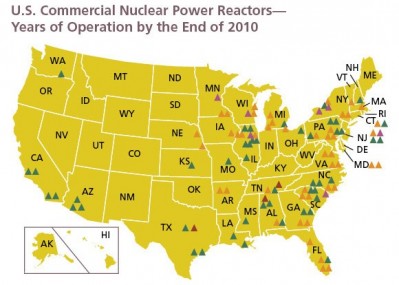
More proof that the decision to table the Yucca Moutain storage site is purely political. http://www.thebulletin.org/web-edition/columnists/dawn-stover/the-scientization-of-yucca-mountain